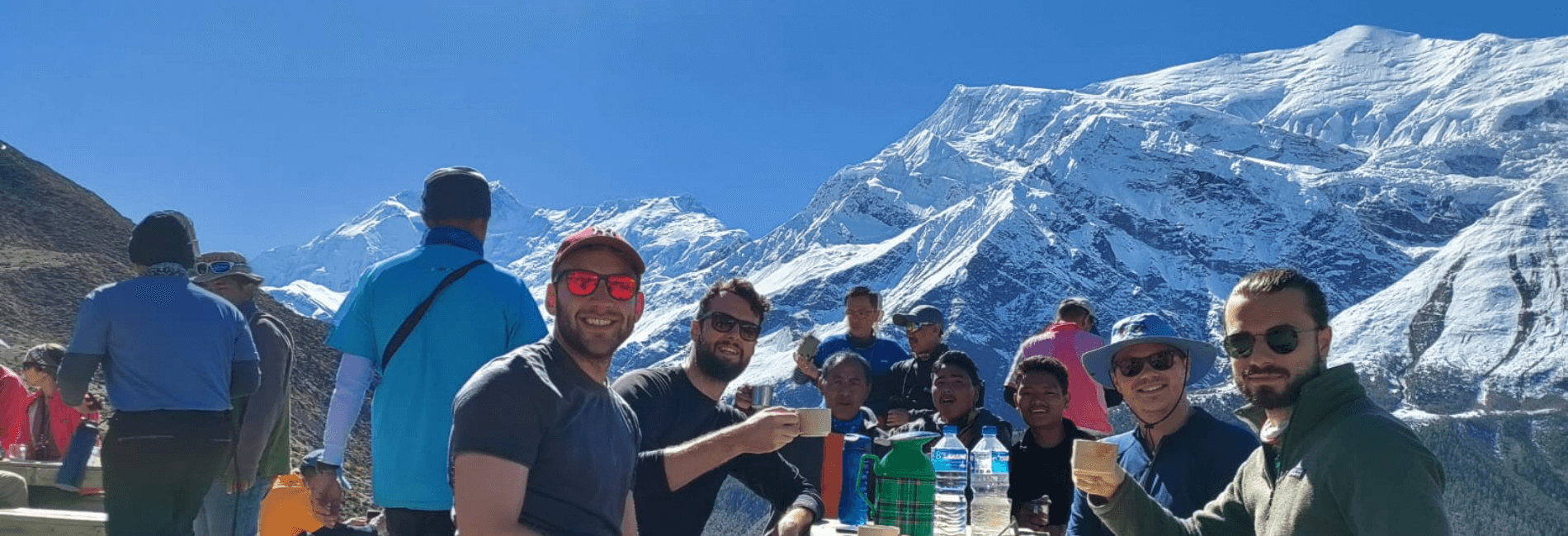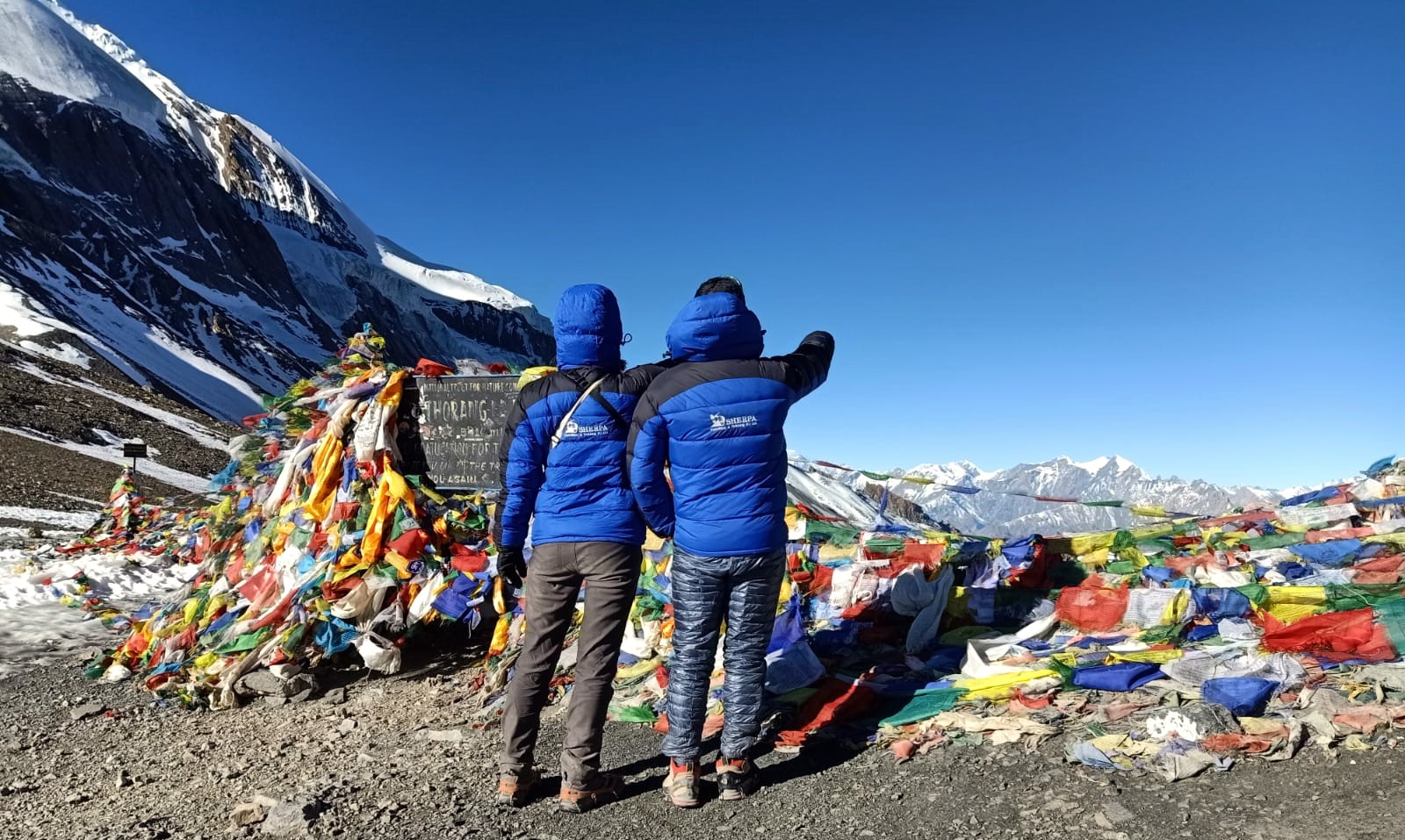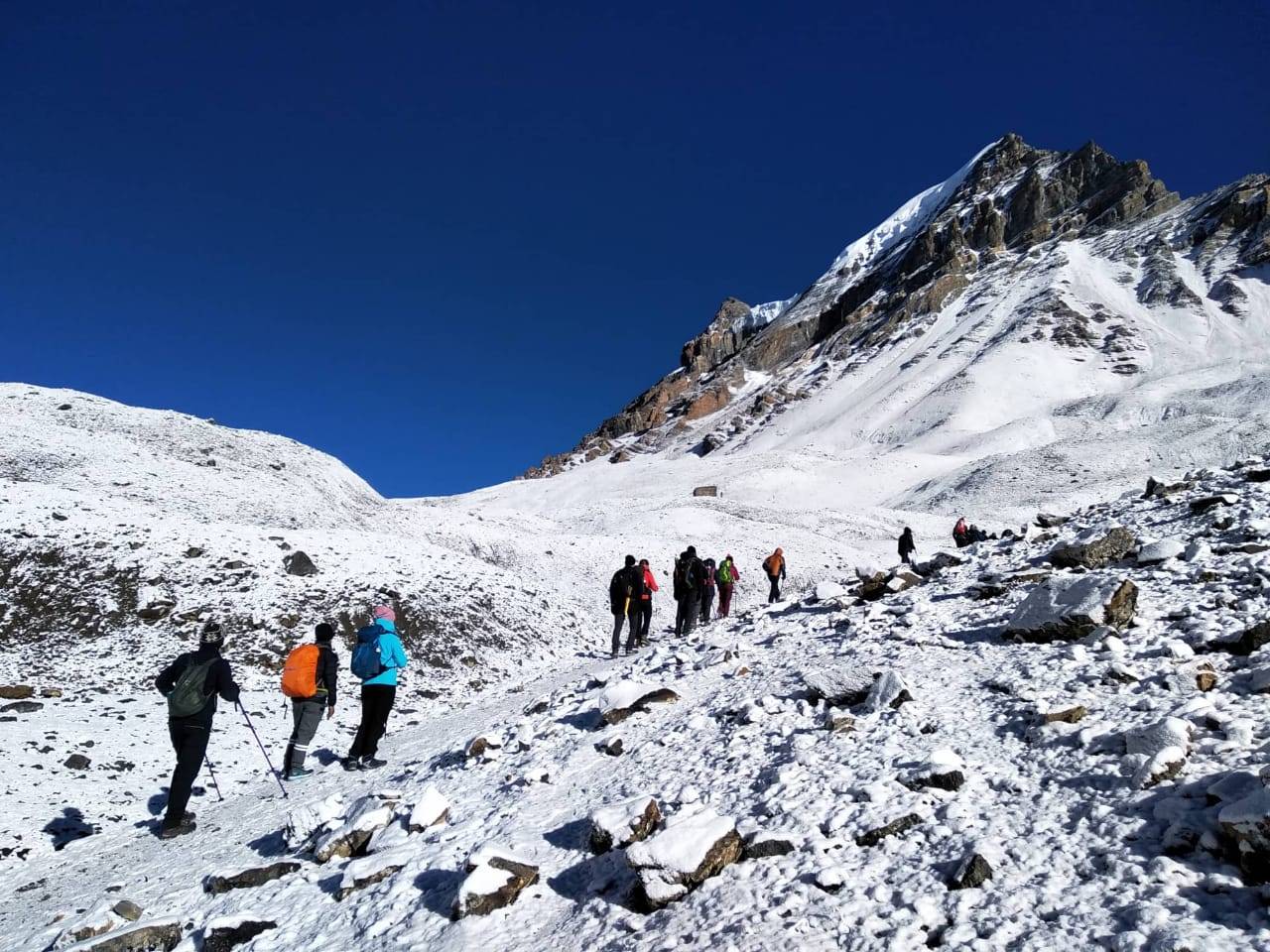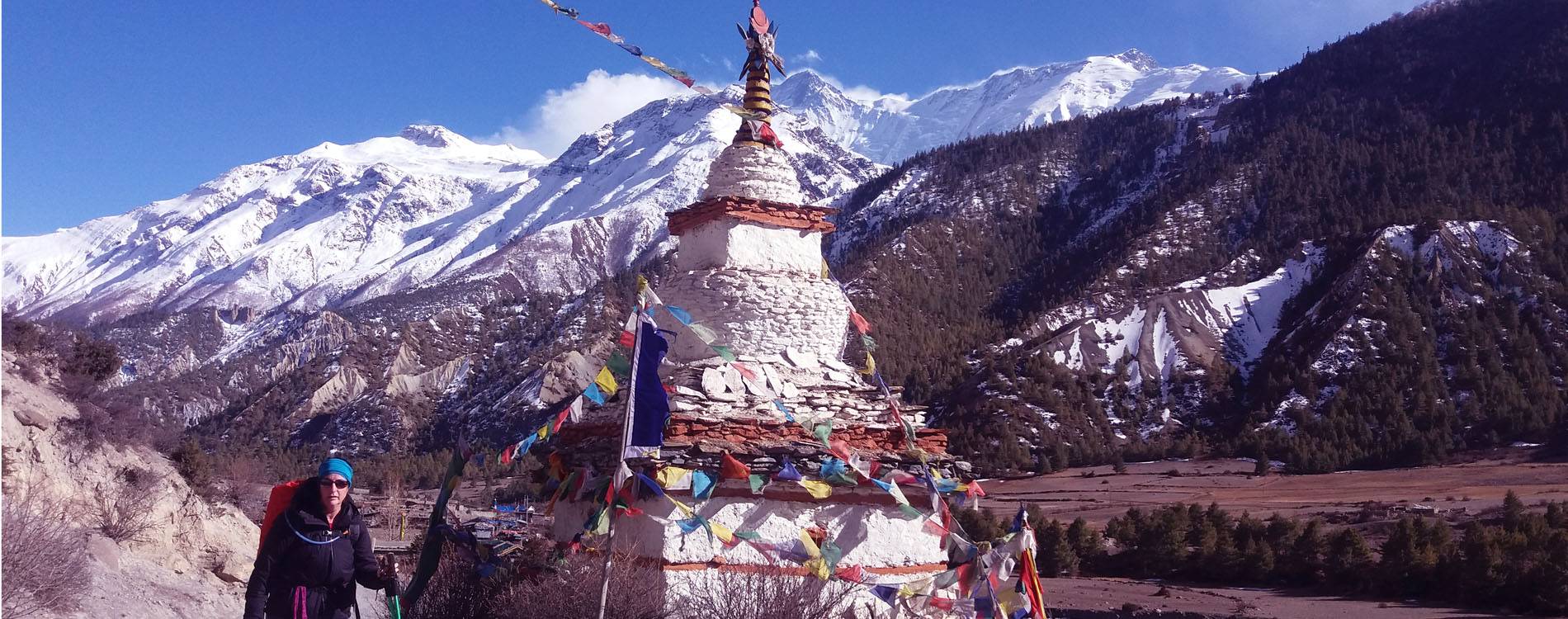26th August, 2025

Dec 31, 2023
Annapurna Circuit Trek in March
- Why March Annapurna Circuit Trek
- What is the weather like in Annapurna in March?
- Which season is best for Annapurna Circuit trek?
- Can you do the Annapurna Circuit in March?
- Can I Do Annapurna Circuit Trek Solo?
- Female Solo Trek to Annapurna Circuit Trek
- Without Guide Annapurna Circuit Trek
- What Are Challenges of Doing Annapurna Circuit in March?
- Preparation for Trek
- Training Recommendation
- Accommodation and Food
- Water
- Trek Safety
- Final Say
- Annapurna Circuit Packages
Trekking the Annapurna Circuit in March is considered one of the best times to experience this iconic route in Nepal. March marks the beginning of spring in the Himalayas, offering favorable weather conditions and stunning landscapes along the trekking route.
Weather during March along the Annapurna Circuit is generally mild and stable. Daytime temperatures at lower elevations range from 10 to 20 degrees Celsius (50 to 68 degrees Fahrenheit), making for comfortable trekking conditions. As you ascend higher, temperatures can vary, but generally remain pleasant during the day and cool at night. The weather is typically dry with clear skies, providing excellent visibility of the surrounding snow-capped peaks and landscapes.
The lush rhododendron forests along the lower altitudes of the trek bloom during March, painting the hillsides with vibrant colors of red, pink, and white. This adds to the scenic beauty of the trek, complemented by terraced fields, traditional villages, and cultural encounters with local communities such as the Gurung and Thakali people.

ANNAPURNA CIRCUIT TREK 7 DAYS
The 7 days Annapurna Circuit Trek is, for a good reason, one of the most popular treks in Nepal’s Annapurna Conservation Area where you will witness enormous snow-covered mountains, deep gorges &...
Accommodation options along the Annapurna Circuit in March are plentiful, with teahouses and lodges offering basic but comfortable amenities such as warm beds and hot meals. The teahouses are less crowded compared to peak seasons like autumn, allowing for a more relaxed and enjoyable trekking experience.
March is also a popular time for trekkers to attempt the Thorong La Pass at 5,416 meters (17,769 feet), the highest point of the Annapurna Circuit. Proper acclimatization and preparation are crucial for this challenging section, but the clear weather and favorable conditions in March make it an ideal time for such endeavors.
Overall, March offers a perfect balance of favorable weather, stunning natural beauty, and cultural experiences, making it an excellent choice for trekking the Annapurna Circuit and creating lasting memories in Nepal's Himalayas.

ANNAPURNA CIRCUIT TREK 8 DAYS
The Annapurna Circuit Trek is, for a good reason, one of the most popular treks in Nepal’s Annapurna Conservation Area where you will witness enormous snow-covered mountains, deep gorges & high al...
Why March Annapurna Circuit Trek
March is an ideal time to trek the Annapurna Circuit for several compelling reasons. The weather is generally mild and stable, with daytime temperatures ranging from 10 to 20 degrees Celsius (50 to 68 degrees Fahrenheit) at lower elevations, creating comfortable trekking conditions. The trails are less crowded compared to peak seasons like autumn, allowing for a more serene and enjoyable trekking experience. March also marks the beginning of spring in the Himalayas, with blooming rhododendrons adding vibrant colors to the landscape, enhancing the scenic beauty of the trek. Additionally, clear skies offer excellent visibility of the snow-capped peaks and surrounding landscapes, perfect for photography and soaking in the breathtaking views.
What is the weather like in Annapurna in March?
In March, the weather in Annapurna is generally mild and pleasant, making it a favorable time for trekking the Annapurna Circuit. Daytime temperatures at lower altitudes range from 10 to 20 degrees Celsius (50 to 68 degrees Fahrenheit), while temperatures can drop at higher elevations, especially at night. The weather is typically dry with clear skies, providing excellent visibility of the majestic Himalayan peaks and the surrounding landscapes. As spring begins, the trekking route features blooming rhododendrons, adding vibrant colors to the scenery. Trekkers can expect comfortable trekking conditions during March, although it's essential to be prepared for potential weather changes in the mountains.

ANNAPURNA CIRCUIT WITH TILICHO LAKE TREK 15 DAYS
This 15-day trek takes you through the Annapurna Conservation Area and to the highest alpine pass in the world – Thorong La Pass (5,416m/17,769ft) and to Tilicho Lake. You will also trek through the d...
Which season is best for Annapurna Circuit trek?
The best seasons for trekking the Annapurna Circuit are generally autumn (September to November) and spring (March to May). These seasons offer mild temperatures, stable weather conditions, clear skies, and breathtaking views of the Himalayas. Autumn is known for its crisp air, vibrant landscapes, and post-monsoon clarity, making it the busiest but most popular time for trekking. Spring brings blooming rhododendrons and warmer temperatures, ideal for enjoying the natural beauty of the region. While winter (December to February) can also be a good time for experienced trekkers seeking quieter trails and snowy landscapes, it requires preparation for cold weather and potential snowfall. Summer (June to August) is monsoon season, with heavy rainfall and difficult trail conditions, making it less suitable for trekking.
Can you do the Annapurna Circuit in March?
Yes, you can trek the Annapurna Circuit in March. March offers favorable weather conditions, comfortable temperatures, and clear skies, making it an excellent time for trekking. The trails are less crowded compared to peak seasons like autumn, providing a quieter and more relaxed trekking experience. The beginning of spring brings blooming rhododendrons, adding to the scenic beauty of the trekking route. Trekkers can enjoy panoramic views of the snow-capped Himalayan peaks and immerse themselves in the rich cultural heritage of the region. Accommodation options along the Annapurna Circuit are plentiful, with teahouses and lodges offering basic but comfortable amenities. It's essential to prepare adequately for the trek, including obtaining necessary permits, packing appropriate gear, and ensuring physical fitness for the challenges of high-altitude trekking. Overall, March is a fantastic time to trek the Annapurna Circuit, offering a perfect balance of favorable weather, stunning landscapes, and cultural experiences in Nepal's Himalayas.

ANNAPURNA CIRCUIT WITH TILICHO LAKE TREK 14 DAYS
This trek Opened for tourists in 1980, the Annapurna region has been recognized as one of the world's popular trekking destination destinations according to a recent survey by the American magazine Mo...
Can I Do Annapurna Circuit Trek Solo?
Trekking the Annapurna Circuit solo is possible and increasingly popular among adventurous travelers. Solo trekkers have the flexibility to set their own pace and itinerary, allowing for a more personalized trekking experience. However, it's essential to consider several factors before embarking on a solo trek, including physical fitness, prior trekking experience, and familiarity with high-altitude conditions. Solo trekkers should also be well-prepared with navigation skills, emergency procedures, and adequate supplies. While the trail is well-marked and frequented by other trekkers, having a thorough understanding of the route and potential risks is crucial for safety and enjoyment.
Female Solo Trek to Annapurna Circuit Trek
Female solo trekking on the Annapurna Circuit is feasible with proper preparation and caution. Nepal is generally safe for solo female travelers, and many women have successfully completed the trek independently. It's advisable to choose reputable accommodations and stay on well-traveled paths. Connecting with other trekkers or joining guided groups along the way can enhance safety and provide companionship. Carrying essential safety items like a whistle, headlamp, and personal locator beacon (PLB) is also recommended. By maintaining awareness and making informed decisions, female solo trekkers can enjoy the beauty and adventure of the Annapurna Circuit while prioritizing their safety.

ANNAPURNA CIRCUIT WITH TILICHO LAKE TREK 9 DAYS
Short 9 Days Annapurna Circuit Trek with Tilicho Lake is one of the most impressive and challenging hikes in Nepal. It’s an incredibly popular trekking destination in Nepal and around the world given...
Without Guide Annapurna Circuit Trek
Trekking the Annapurna Circuit without a guide is an option for experienced trekkers who are confident in their abilities to navigate and manage the trek independently. The trail is well-established with clear markings and frequent teahouses, making it feasible for self-guided treks. However, trekking without a guide requires thorough preparation, including obtaining necessary permits, packing appropriate gear, and planning a detailed itinerary. Trekkers should be proficient in map reading, GPS navigation, and have a good understanding of altitude sickness symptoms and prevention. While guides provide local insights and support, independent trekkers can enjoy the flexibility and freedom to explore at their own pace. It's crucial to prioritize safety by staying informed about weather conditions, trail updates, and emergency contacts throughout the trek.
What Are Challenges of Doing Annapurna Circuit in March?
Trekking the Annapurna Circuit in March presents several challenges despite its favorable weather conditions. One major challenge is the variability in weather, where early March can still experience remnants of winter with potential snow and icy trails, especially at higher elevations like Thorong La Pass. Trekkers must be prepared for sudden weather changes and colder temperatures, requiring appropriate gear such as insulated clothing and waterproof layers. Accommodation and teahouse availability can also be limited in remote areas due to fewer tourists, necessitating early booking or flexibility in travel plans.

ANNAPURNA CIRCUIT TREK
A LIFE-CHANGING EXPERIENCE – incredible beauty!Circumnavigate the Annapurnas – with one peak at 8091m & 28 peaks over 6000m surrounded by the Kali Gandaki Gorge, Marshyangdi River & Pokhara in...
Preparation for Trek
Effective preparation is essential for a successful Annapurna Circuit trek in March. Start by obtaining necessary permits like the TIMS card and ACAP permit in Kathmandu or Pokhara. Plan a detailed itinerary considering altitude gains to aid acclimatization and ensure gradual ascent to reduce the risk of altitude sickness. Pack essential gear including cold-weather clothing, sturdy hiking boots, trekking poles, and a reliable sleeping bag rated for sub-zero temperatures. Familiarize yourself with emergency procedures and carry a comprehensive first aid kit.
Training Recommendation
Prioritize cardiovascular endurance and leg strength for the Annapurna Circuit trek. Begin a fitness regimen several months before departure, incorporating activities like hiking, jogging, cycling, and stair climbing to build stamina. Practice trekking with a loaded backpack to simulate trekking conditions and improve endurance. Focus on building strength in the legs through squats, lunges, and calf raises to prepare for steep ascents and descents encountered along the trail.

ANNAPURNA CIRCUIT TREK
A LIFE-CHANGING EXPERIENCE – incredible beauty!Circumnavigate the Annapurnas – with one peak at 8091m & 28 peaks over 6000m surrounded by the Kali Gandaki Gorge, Marshyangdi River & Pokhara in...
Accommodation and Food
Accommodation along the Annapurna Circuit in March ranges from basic teahouses to more comfortable lodges in larger villages. Teahouses offer simple but adequate facilities such as beds with blankets, hot meals, and sometimes warm showers. Lodging availability can be limited in remote areas, so it's advisable to book in advance during peak trekking seasons. The menu typically includes Nepali staples like dal bhat (rice and lentils), noodles, soups, and occasional Western dishes. Trekkers should carry snacks like energy bars and dried fruits for additional sustenance, especially in less populated areas.
Water
Access to safe drinking water is crucial during the trek. While bottled water is available at teahouses, it's environmentally friendly to use water purification tablets or filters to treat water from natural sources like streams and taps. Stay hydrated throughout the trek to prevent altitude-related illnesses and maintain energy levels.

15 DAYS ANNAPURNA CIRCUIT TREK
A WILD ADVENTURE AMONG SOARING PEAKS - THE DEEPEST VALLEY ON EARTH & EXPOSURE TO UNIQUE CULTURES.THIS TREK HAS IT ALL!The 15 Days Annapurna Circuit Trek is time well spent and will leave you with...
Trek Safety
Ensuring trek safety on the Annapurna Circuit involves careful preparation, adherence to weather forecasts, and maintaining awareness of personal health and surroundings. Monitor altitude symptoms, acclimatize properly, and heed local advice regarding trail conditions and weather updates. Carry essential safety equipment, communicate your itinerary with trusted contacts, and consider hiring a local guide for added support and cultural insights. With adequate preparation and mindfulness, trekkers can safely enjoy the breathtaking landscapes and cultural richness of the Annapurna Circuit in March.
Final Say
In conclusion, trekking the Annapurna Circuit, whether in March or any other month, offers a profound adventure amidst the majestic Himalayan landscapes of Nepal. March, with its favorable weather, blooming rhododendrons, and clearer skies, presents an excellent opportunity for trekkers to experience the beauty of the region. However, it's crucial to approach this trek with thorough preparation and respect for its challenges.
Preparing adequately includes obtaining necessary permits, packing suitable gear for varying weather conditions, and ensuring physical fitness and mental readiness for the demands of high-altitude trekking. Trekkers should prioritize safety by monitoring their health, staying hydrated, and acclimatizing properly to prevent altitude sickness.

14 DAYS ANNAPURNA CIRCUIT TREK
RECOMMENDED WORLDWIDE! VISIT THE HIGHEST PASS & DEEPEST GORGE. An opportunity of a lifetime and adventure seeker’s paradise!The Annapurna Circuit Trek in 14 days with a drive to Chame and Muk...
Accommodation along the route ranges from basic teahouses to more comfortable lodges, offering warmth and sustenance amidst the trek. Local cuisine and cultural encounters enrich the journey, providing a deeper connection to the region and its people.
Ultimately, the Annapurna Circuit is not just a physical journey but a transformative experience that rewards trekkers with stunning vistas, cultural insights, and personal achievement. Whether trekking solo or with companions, embracing the challenges and joys of the Annapurna Circuit promises memories and lessons that endure far beyond the trek itself.
Annapurna Circuit Packages
10 Days Annapurna Circuit Trek
12 Days Annapurna Circuit Trek
14 Days Annapurna Circuit Trek
15 Days Annapurna Circuit Trek
Annapurna Circuit With Tilicho Lake Trek 9 Days
Annapurna Circuit With Tilicho Lake Trek 15 Days

12 DAYS ANNAPURNA CIRCUIT TREK
This classic 12 Days Annapurna Circuit Trek is one of the most popular treks in Nepal. Every year thousands embark on this adventure and return with memories to last a lifetime! On this trek you...
Any Questions? Let Us Know.
Recent Posts
17th June, 2025


















